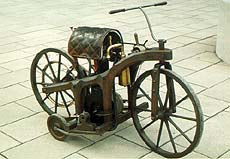Motorcycle
Today, let's talk about biking, flying, and the metaphorical power of a machine. The University of Houston's College of Engineering presents this series about the machines that make our civilization run, and the people whose ingenuity created them.
A stray dog attached herself to me two years ago. A running dog with a happy face. A dog who loves motorcycles. Early in life, she'd learned that this creature, with an engine, wheels, and a helmeted head, is greatly to be desired. Her old owner had to be a biker. So I ask my wife, "Tell me quick -- don't think: What do you see when I say motorcycle? "Menace and speed," she says. "Noise --and fun! I think of Darth Vader's black helmet."
The history of the motorcycle -- this rumbling, snorting, centaur, half human, half iron -- is only a century old. It began just as soon as the bicycle took its modern form in 1885.
Nicholaus Otto, who invented the Otto Cycle, had an assistant, Gottlieb Daimler. Daimler left Otto to develop his own engine. In 1885 he made a wooden bike. He drove it with his engine instead of with a pedal arrangement. But there was a catch:
Daimler's motorcycle had two small stabilizing wheels --like a kid's training bike. It was actually a four-wheeled vehicle. Daimler soon went on to build early automobiles. He left it to bicycle builders to develop the two-wheeled motorcycle.
They had problems to solve. Where should the motor go? It was soon clear that, for stability, it should ride between the wheels, close to the ground. How many cylinders should the engine have? Should it be a two-stroke or four-stroke cycle? Should you keep pedals and a chain, or could you abandon them?
All the while a remarkable split was taking place between the builders of bikes and the builders of automobiles. Automobile inventors had greater kinship with the railroads. Indeed, many of the first autos, like locomotives, were steam-powered.
But it was bicycle makers who went into the air. Biking and flying have always been kin. A lightness of being attends both modes of motion. You feel the wind; you feel movement. Cars and trains aim to insulate you from that intimacy with motion. It's no accident that motorcycle and airplane speed records were almost the same until WW-I.
Harley-Davidson made their first V-twin bike in 1907. It distinguished itself by climbing hills. Like the airplane, the bike is a metaphor for shedding constraints -- of gravity and of society. Motorcycles have climbed and jumped and made their owners rebels for a day. They've moved faster than life. The fast ones now go 160 mph. Some have set records that top 200.
So my dog sees a single creature with two wheels and a helmeted head. It's Darth Vader, earthbound perhaps, but only barely. It's Luke Skywalker skimming the forest floor, two feet off the ground. It is a metaphor for the buoyancy of being.
I'm John Lienhard, at the University of Houston, where we're interested in the way inventive minds work.
(Theme music)
Wilson, H., The Ultimate Motor-Cycle Book. London: Dorling Kindersley, 1993.
I am grateful to Kieth Hollingsworth, UH Mechanical Engineering Department, for providing the remarkable Wilson source book and for suggesting the topic.
For more an even earlier motorcycle, see Episode 1286.
The following illustration of Daimler's first motorcycle (with "training wheels") is first of the many pictures they offer:
